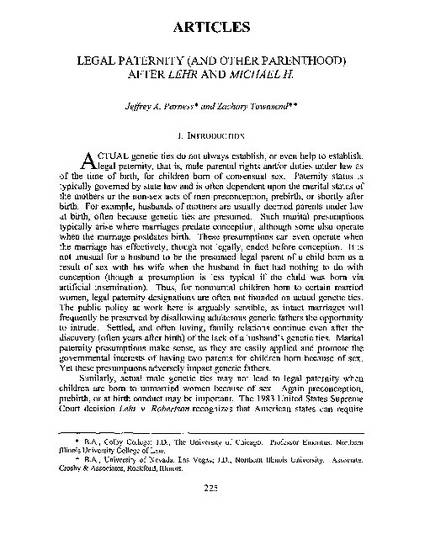
Actual genetic ties do not always establish, or even help to establish, legal paternity of children born of consensual sex, that is, male parental rights and/or duties as of the time of birth. Paternity status, typically governed by state law, is often dependent upon the marital status of the mothers, or the nonsex acts of men preconception, prebirth, or shortly after birth. For example, husbands of mothers are often deemed parents at birth because genetic ties are presumed. Thus, for nonmarital children born to certain married women, legal paternity is not founded on actual genetic ties. Similarly, actual male genetic ties may not lead to paternity when children are born of sex to unmarried women. Again preconception, prebirth or at birth conduct may be important. The 1983 United States Supreme Court decision in Lehr v. Robertson recognizes that American states can require natural fathers, at least in the adoption setting, to do more than prove genetic ties in order to acquire paternity. When such fathers do enough, they acquire “substantial” federal constitutional childrearing interests so that any proposed adoption requires their consent. When such fathers do not do enough, Lehr allows states to deny them legal parentage. Lehr does forbid states from omitting too many natural fathers from governmental schemes for eliminating parental interests. And Lehr does not forbid a state, at least within adoption, from designating legal paternity for a nonmarital child in a man with no genetic ties. Many American states, in fact, say that genetic ties alone are an insufficient basis for legal paternity. And, within adoption, and often elsewhere, states recognize childrearing interests in nonmarital children for certain nongenetic fathers. The U.S. Supreme Court has said little since Lehr about male parentage under law for nonmarital children born of sex. It has, however, spoken on legal paternity for children of married mothers whose husbands are not the genetic fathers, a different breed of nonmarital children. In Michael H. v. Gerald D. in 1989, the court recognized that an American state could create an irrebuttable presumption of genetic ties in a husband for a child born during marriage where the marriage remains intact after birth and the married couple chooses to raise the child. After reviewing Lehr and Michael H., we find the Lehr guidelines have not been properly followed in and outside of adoption, including safe haven and custody/visitation settings. We also review American paternity laws in child support, torts and inheritance settings where male childrearing is not always at issue. Along the way we explore the possible expansion of Lehr’s childrearing opportunity interests in children born of sex to those uninvolved in sex. We conclude that Lehr rights should be expanded to natural fathers outside adoption and to certain nongenetic parents, including both women and men.